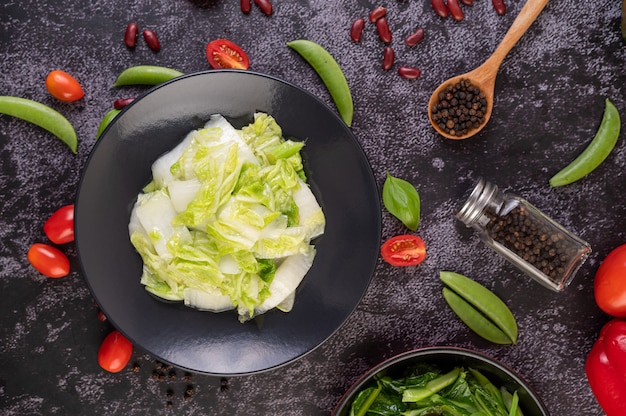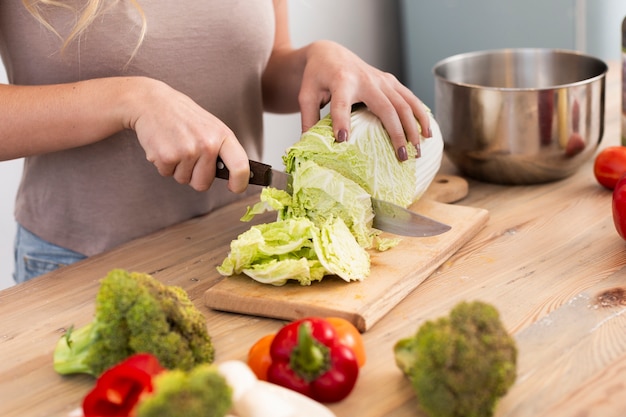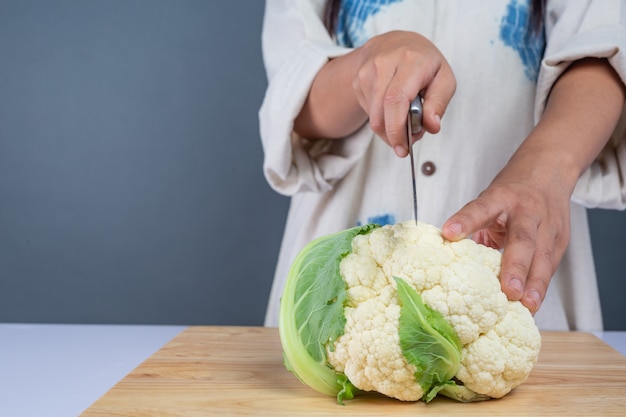Let's face it, cabbage has gotten a bit of a bad rap. It's often relegated to the boiled-and-mushy corner of the vegetable world. But trust me, there's so much more to this humble head of greens. It's incredibly versatile, packed with nutrients, and can be transformed into a multitude of delicious dishes, from simple sides to flavour-packed centrepieces.
This guide isn't just about recipes, it's a journey into the world of cabbage. I'll share my personal experiences, favourite techniques, and secrets for unlocking the true potential of this often overlooked vegetable. Grab your apron, put the kettle on, and let's get cooking!
(Part 1) Choosing the Right Cabbage

A World of Cabbages
The first step to mastering cabbage is understanding the different types available. Each variety boasts its own unique texture and flavour, making it perfect for specific dishes.
Green Cabbage: This is the classic, go-to cabbage you'll find in most supermarkets. Its firm texture and slightly bitter flavour make it perfect for coleslaw, soups, and stews.
Red Cabbage: Its vibrant purple hue adds a pop of colour to dishes, and it has a sweeter flavour than green cabbage. I love it in salads, sauerkraut, and as a base for vibrant slaws.
Savoy Cabbage: This delicate variety has a slightly crinkled texture and a milder flavour. It's great for braising or steaming, and its delicate leaves can be used to wrap fillings for savoury parcels.
Chinese Cabbage: This crisp, sweet cabbage with its slightly nutty flavour is fantastic in stir-fries, salads, and as a wrap for dumplings.
Napa Cabbage: A close relative of Chinese cabbage, Napa is often used in Korean cuisine. Its crunchy texture and subtle sweetness shine in kimchi, soups, and stir-fries.
Selecting the Best Cabbage
When choosing a cabbage, keep these tips in mind:
Firmness is Key: A good cabbage should be firm to the touch, with no soft spots or signs of bruising. If it feels squishy, it's likely past its prime.
Check for Freshness: The leaves should be crisp and vibrant green, free from wilting or yellowing. Avoid cabbage with brown or discoloured leaves.
Avoid Damaged Heads: Any cracks, cuts, or holes in the cabbage indicate it might have been mishandled and could be susceptible to spoilage.
(Part 2) Preparing Cabbage for Cooking

Washing and Trimming
Cabbage is surprisingly easy to prepare. Start by rinsing it thoroughly under cold water, making sure to remove any lingering dirt or debris. Then, cut off the outer leaves, which tend to be tougher and less appealing. I typically remove two to three layers, depending on the size of the cabbage.
Slicing, Dicing, and Shredding
Now comes the fun part – the chopping! The way you cut your cabbage depends on the dish you're making. For a classic coleslaw, I highly recommend a mandoline for thin, even slices. It's a game-changer! A sharp chef's knife works well too, but be careful to slice through the cabbage consistently.
For stir-fries or a zesty coleslaw, I use a grater or a food processor for a fine, shredded cabbage. This creates a beautiful texture that coats beautifully in sauces. And for soups or stews, I prefer chunky chunks that add a hearty element to the dish.
(Part 3) Cooking Cabbage to Perfection

The Art of Boiling
Boiling is the simplest way to cook cabbage. You can boil it whole, cut it into wedges, or chop it into pieces. This method softens the cabbage and removes any bitterness, making it ideal for adding to soups, stews, or using as a base for other dishes.
Tip: Add a pinch of salt to the boiling water to help retain the cabbage's vibrant colour and enhance its flavour.
Steaming for a Healthier Approach
Steaming cabbage preserves its nutrients and results in a tender, flavorful outcome. You can use a dedicated steamer basket or improvise with a saucepan and a lid. Simply place the cabbage in the steamer, add a small amount of water to the bottom of the pot, and bring it to a simmer.
Tip: A few drops of lemon juice added to the steaming water will prevent the cabbage from discolouring and maintain its freshness.
Sautéing for Speed and Flavor
Sautéing is a quick and easy way to cook cabbage and achieve a slightly caramelised flavour. Heat some oil in a pan over medium heat and add the prepared cabbage. Cook, stirring frequently, until it softens and turns a light golden brown.
Tip: Add a splash of vinegar or soy sauce towards the end of cooking for an extra kick of flavour.
Braising for Ultimate Tenderness
Braising is a slow and gentle cooking method that transforms cabbage into a meltingly tender and flavourful masterpiece. Place the cabbage in a dutch oven or a pot with a tight-fitting lid, add a flavorful braising liquid like broth or wine, and simmer until the cabbage is tender and infused with flavour.
Tip: Use a combination of aromatic vegetables like onions, carrots, and celery to add depth to the braising liquid.
Roasting for Caramelized Bliss
Roasting unleashes the natural sweetness of cabbage and creates a delicious caramelised exterior with a tender interior. Toss the prepared cabbage with olive oil, salt, pepper, and your favourite spices, then roast in a preheated oven until it turns golden brown and slightly crisp.
Tip: Add a drizzle of honey or maple syrup before roasting for an extra touch of sweetness and a beautiful glaze.
(Part 4) simple cabbage recipes
Now for the fun part! These are some of my go-to cabbage recipes that are quick, easy, and always a hit.
(4.1) Quick and Easy Cabbage Slaw
Ingredients:
1 small green cabbage, thinly sliced
1/2 cup mayonnaise
1/4 cup sour cream
1 tablespoon white vinegar
1 tablespoon sugar
Salt and pepper to taste
Instructions:
1. In a large bowl, combine the sliced cabbage, mayonnaise, sour cream, vinegar, and sugar.
2. Season generously with salt and pepper.
3. Toss everything together until the cabbage is evenly coated in the dressing.
4. Serve immediately or chill for a refreshing bite.
(4.2) Cabbage and Sausage Stir-Fry
Ingredients:
1 tablespoon oil
1 pound sausage, sliced
1/2 head green cabbage, shredded
1/2 cup chicken broth
1 tablespoon soy sauce
1 tablespoon rice vinegar
Salt and pepper to taste
Instructions:
1. Heat the oil in a large skillet or wok over medium heat.
2. Add the sausage slices and cook, stirring occasionally, until they are nicely browned.
3. Add the shredded cabbage and cook for about 5 minutes, until it's tender but still has a slight crunch.
4. Pour in the chicken broth, soy sauce, and rice vinegar.
5. Season with salt and pepper, stir everything together, and cook for another minute until the sauce thickens slightly.
6. Serve immediately over rice or noodles.
(4.3) Creamy Cabbage Soup
Ingredients:
1 tablespoon butter
1 onion, chopped
2 carrots, chopped
2 celery stalks, chopped
1/2 head green cabbage, chopped
4 cups chicken broth
1 cup heavy cream
Salt and pepper to taste
Instructions:
1. Melt the butter in a large pot over medium heat.
2. Add the onion, carrots, and celery and cook for about 5 minutes, until they soften.
3. Add the chopped cabbage and chicken broth. Bring the mixture to a boil, then reduce the heat and simmer for 15 minutes, or until the cabbage is tender.
4. Stir in the heavy cream and season generously with salt and pepper.
5. Serve hot and enjoy a comforting bowl of creamy goodness.
(Part 5) Cabbage Recipes with a Twist
Now let's explore some more adventurous recipes that will showcase the versatility of cabbage.
(5.1) Cabbage and Apple Salad with Walnut Dressing
Ingredients:
1/2 head red cabbage, thinly sliced
2 apples, diced
1/2 cup walnuts, chopped
1/4 cup olive oil
2 tablespoons apple cider vinegar
1 tablespoon honey
Salt and pepper to taste
Instructions:
1. In a large bowl, combine the sliced red cabbage, diced apples, and chopped walnuts.
2. In a small bowl, whisk together the olive oil, apple cider vinegar, honey, salt, and pepper until a smooth dressing is formed.
3. Pour the dressing over the salad and toss gently to coat everything evenly.
4. Taste and adjust the seasonings as needed.
5. Serve immediately or chill for a refreshing side dish.
(5.2) Spicy Kimchi fried rice
Ingredients:
2 tablespoons oil
1 cup cooked rice
1/2 cup kimchi, chopped
1/2 head Napa cabbage, shredded
1/2 cup chopped onion
2 eggs, beaten
1 tablespoon soy sauce
1 teaspoon sesame oil
Salt and pepper to taste
Instructions:
1. Heat the oil in a large skillet or wok over medium heat.
2. Add the cooked rice, chopped kimchi, shredded Napa cabbage, and chopped onion. Stir-fry for about 5 minutes until the cabbage is tender and the rice is heated through.
3. Push the rice mixture to one side of the pan and pour in the beaten eggs. Scramble the eggs until they are cooked through.
4. Combine the rice mixture and scrambled eggs.
5. Stir in the soy sauce, sesame oil, salt, and pepper.
6. Serve immediately, garnished with chopped green onions or sesame seeds, if desired.
(5.3) Cabbage and chickpea curry
Ingredients:
1 tablespoon oil
1 onion, chopped
2 cloves garlic, minced
1 inch ginger, grated
1 teaspoon ground cumin
1 teaspoon ground coriander
1/2 teaspoon turmeric
1/4 teaspoon cayenne pepper
1 can (14 ounces) diced tomatoes
1 cup vegetable broth
1/2 head green cabbage, chopped
1 can (15 ounces) chickpeas, drained and rinsed
Salt and pepper to taste
Fresh cilantro, for garnish
Instructions:
1. Heat the oil in a large pot over medium heat.
2. Add the chopped onion, minced garlic, and grated ginger. Cook for about 5 minutes until the onion softens and becomes translucent.
3. Stir in the ground cumin, coriander, turmeric, and cayenne pepper. Cook for another minute, stirring constantly, until the spices release their fragrant aromas.
4. Add the diced tomatoes, vegetable broth, chopped cabbage, and drained chickpeas. Bring the mixture to a boil, then reduce heat to a simmer.
5. Simmer for about 20 minutes, or until the cabbage is tender and the flavors have melded beautifully.
6. Season the curry with salt and pepper to taste.
7. Serve hot, garnished with fresh cilantro for a vibrant finish.
(Part 6) cabbage storage and Leftovers
Keeping Cabbage Fresh
Proper storage is essential to keep your cabbage fresh and flavorful for as long as possible. I wrap my cabbage tightly in plastic wrap and store it in the crisper drawer of my refrigerator. It should last for about a week to two weeks this way.
Repurposing Leftovers
Don't let those leftover cabbage scraps go to waste! They're perfect for adding to stir-fries, soups, stews, or even salads. The cooked cabbage will soften further, adding a unique texture and depth of flavour to your next meal.
(Part 7) Cabbage and Health Benefits
Cabbage is more than just a delicious vegetable; it's a powerhouse of nutrients. Packed with vitamins, minerals, and antioxidants, it makes a healthy addition to any diet.
A Vitamin and Mineral Treasure
Cabbage is an excellent source of Vitamin C, Vitamin K, and folate, essential nutrients for maintaining overall health and well-being. It also contains potassium, calcium, and fiber, which contribute to strong bones, balanced electrolytes, and a healthy digestive system.
Antioxidant Powerhouse
Cabbage is packed with antioxidants, compounds that protect your cells from damage caused by free radicals. These antioxidants have been linked to a lower risk of chronic diseases such as heart disease and certain types of cancer.
(Part 8) FAQs About Cabbage
Q1: What’s the best way to get rid of the bitterness in cabbage?
A: The trick to taming bitterness in cabbage is to pair it with sweetness and acidity. Adding a touch of sugar, honey, or maple syrup will balance the bitterness, while a splash of lemon juice or vinegar will further brighten the flavour profile.
Q2: Is it normal for my cabbage to have a slightly pungent odour?
A: Yes, cabbage can have a slightly pungent smell, especially when cut or cooked. This is due to the presence of sulfur compounds, which also contribute to its unique flavour. Don’t worry, it's perfectly normal!
Q3: Can I freeze cabbage?
A: You can freeze cabbage, but it's best to blanch it first. This process involves briefly immersing the cabbage in boiling water, then transferring it to ice water to stop the cooking process. Blanching helps to preserve the texture and colour of the cabbage.
Q4: What can I do with leftover cabbage cores?
A: Don't toss those cores away! They are packed with nutrients and can be used to make a flavorful vegetable broth or added to your compost bin.
Q5: Why is my cabbage turning yellow?
A: Cabbage can turn yellow if it's not stored properly. Exposure to air and light can cause the cabbage to discolour. Try storing it in a cool, dark place, and wrap it in plastic wrap to keep it fresh.
(Part 9) Conclusion
From choosing the right variety to exploring creative recipes, I hope this guide has opened your eyes to the culinary world of cabbage. This humble vegetable is a versatile and delicious ingredient that deserves a place in your kitchen. So get creative, experiment with different recipes, and enjoy the amazing flavour and health benefits of cabbage! Happy cooking!
Everyone is watching

How to Cook Frozen Lobster Tails Perfectly: A Step-by-Step Guide
RecipesLobster. Just the word conjures up images of lavish meals, special occasions, and a taste of luxury. But let's...

Pigs in a Blanket Cooking Time: How Long to Bake for Perfect Results
RecipesAh, pigs in a blanket. Just the name conjures up images of those delightful little parcels of crispy pastry en...

Pork Fillet Cooking Time: How Long to Cook It Perfectly
RecipesPork fillet, or tenderloin as it's sometimes called, is a real favourite in our house. It's so versatile, and...

The Ultimate Guide to Cooking Delicious Frankfurters
RecipesLet's face it, we all love a good frankfurter. It's a classic, simple, and always satisfying. But let's be rea...

Wolf Meat Recipes: A Guide to Cooking Wild Game
RecipesLet's be honest, you don't see wolf meat at your local butcher shop every day. It's a bit of a wild card, but ...
